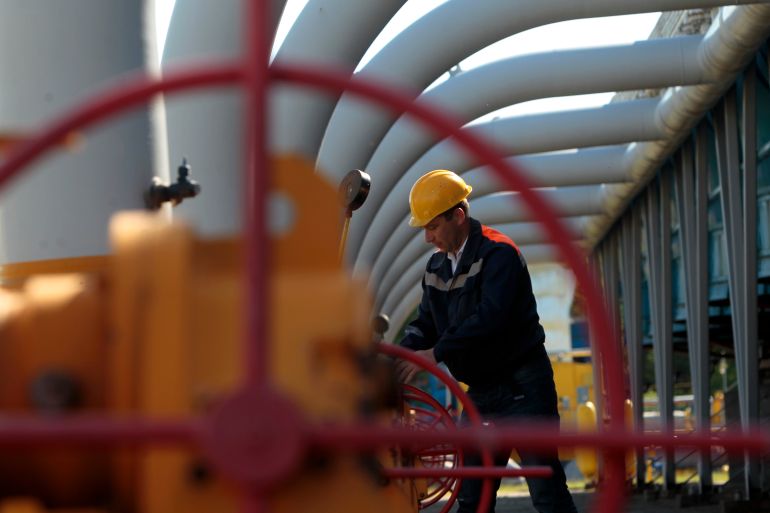Russian gas flows to Europe via Ukraine fall as Kyiv shuts route
The transit point Ukraine shut usually handles about 8 percent of Russian gas flows to Europe.

Russian gas flows to Europe via Ukraine fell by a quarter after Kyiv halted use of a major transit route blaming interference by occupying Russian forces, the first time exports via Ukraine have been disrupted since the invasion.
Ukraine has remained a major transit route for Russian gas to Europe even after Moscow launched what it calls a “special military operation” on February 24.
Keep reading
list of 3 itemsRussian gas crisis: 5 things to know about Europe’s supply
EU warns companies not to buy Russian gas in rubles
The transit point Ukraine shut usually handles about 8 percent of Russian gas flows to Europe, although European states said they were still receiving supplies. The Ukraine corridor mostly sends gas to Austria, Italy, Slovakia and other east European states.
Kremlin-controlled Gazprom, which has a monopoly on Russian gas exports by pipeline, said it was still shipping gas to Europe via Ukraine, but volumes were seen at 72 million cubic metres (mcm) on Wednesday, down from 95.8 mcm on Tuesday.
GTSOU, which operates Ukraine’s gas system, said on Tuesday it would suspend flows through the Sokhranovka transit point, which it said delivered almost a third of fuel piped from Russia to Europe via Ukraine.
GTSOU said it was declaring “force majeure”, invoked when a business is hit by something beyond its control, and proposed diverting deliveries for Europe to another route, the Sudzha entry point, the biggest of Ukraine’s two crossing points.
GTSOU Chief Executive Sergiy Makogon said Russian occupying forces had started taking gas and sending it to Russia-backed separatist regions in east Ukraine. He did not cite evidence.
The gas pipeline via the Sokhranovka point runs through Ukraine’s Luhansk region, part of which has been under control of pro-Russian separatists. Sudzha lies further northwest.
Kremlin spokesman Dmitry Peskov said Russia remained committed to deals to supply gas, when asked to comment on the dispute with Ukraine about the transit route. He said gas supplier Gazprom had not received advance notice of Ukraine’s move.
Russia’s Gazprom said the security of gas supplies has been undermined by Ukraine shutting one entry point for Russian gas transit to Europe.
Last month, Bulgaria and Poland refused to pay for Russian gas via a new payment mechanism and had their supplies stopped. With the Sokhranovka point now closed, up to a third of Europe’s gas supplies could be disrupted, analysts said.
Wednesday’s disruption drove Europe’s benchmark gas price for the third quarter up to 100 euros per megawatt-hour at the market open before slipping back. The price is more than 250 percent above its level a year ago.
Gazprom said on Tuesday it was not technically possible to shift all volumes to the Sudzha route, as GTSOU proposed.
GTSOU said volumes had been diverted to Sudzha in October 2020 when repairs were carried out on the Sokhranovka route. At that time, it said Sudzha handled 165.1 mcm a day – much more than Tuesday’s total flows through Ukraine of 95.8 mcm.
“Consequently, claims that it is impossible to carry out the transfer of flows from Sokhranovka to Sudzha point are untrue,” GTSOU said in a statement on Facebook.